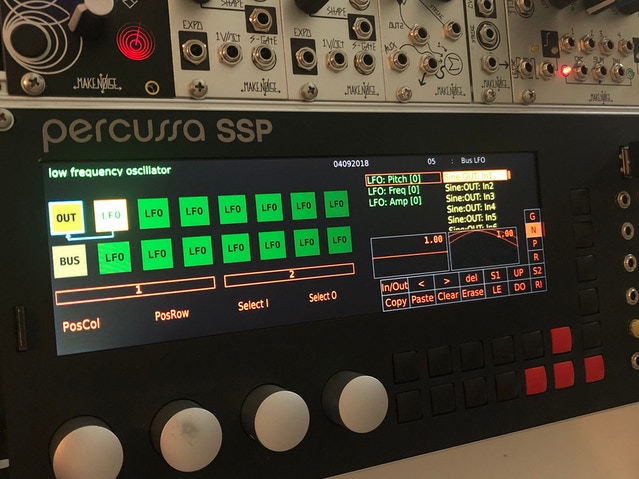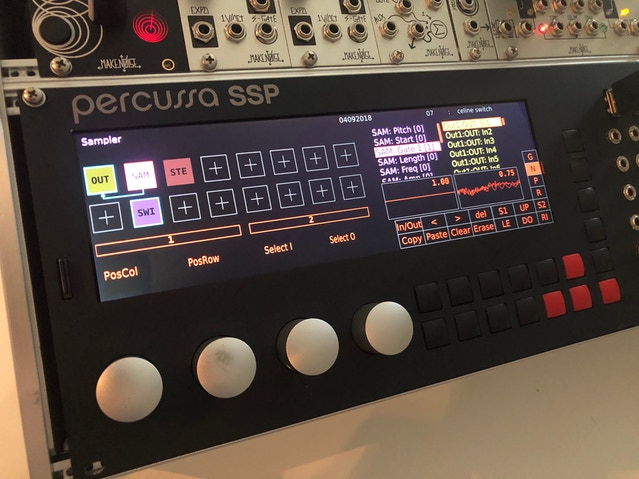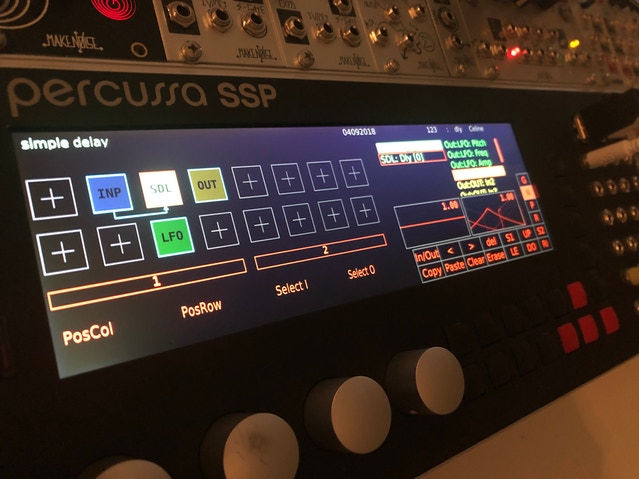Du verwendest einen veralteten Browser. Es ist möglich, dass diese oder andere Websites nicht korrekt angezeigt werden.
Du solltest ein Upgrade durchführen oder einen alternativen Browser verwenden.
Du solltest ein Upgrade durchführen oder einen alternativen Browser verwenden.
Percussa SSP - DSP fürs Eurorack + mSSP
H
hairmetal
Guest
Zwei neue Module und als angekündigtes Kickstarter Stretch-Goal ein drittes.



Update 04092018 - 3 new modules + copy paste feature + bugfixes
* Module copy paste feature has been implemented in the patcher grid (N-page) as requested by @BrettSaberhagen and others. Module parameter settings are copied and multiple-pasting is possible after pressing the copy button once.
* Bug regarding preset selection and loading (lots of turning to select next/previous preset) has now been fixed.
New Module (1/3) - Bus
We added a new module that allows you to route signals anywhere in the patcher grid, which is important if you're working on a big patch spanning multiple pages.
The new BUS module lets you do this. It has 8 inputs and 8 outputs. The input channels are summed to corresponding channels of an internal buffer, and the output channels are read from the internal buffers' channels. You can change the source and destination buffer number via the P-page (there are 64 internal buffers!).
An interesting side effect is that if you wrote data into a buffer and then stop writing to that destination, but then read from the buffer using another bus module, is that the contents are still there and will be looped.

New Module (2/3) - Switcher
We added a signal switcher module as requested by @Mercurial @IvanS and others. The switcher module has a selection input, and a signal input. The selection input is used to route the signal input to any of the 8 outputs of the switcher module.
One example application is to send a gate into the signal input and to connect the 8 outputs to the 8 gate inputs of the sampler such that when the selection input changes, the gate triggers a different sample. You can see this in action in the video below.

New Module (3/3) - Simple Delay [kickstarter stretch goal]
We added a simple delay module, with delay parameter. The delay module has a signal input and output, and simply delays a signal. It can be used of course with any signal, such as audio signals, CVs and gates, internal or external.

siebenachtel
|||||||||||
aus meiner sicht: uninteressant.
gebaut von nem typen der aus meiner sicht nicht gross ahnung hat was er da überhaupt tut.
mein E370 quad VCO hat z.bsp. allein 28 potis.......und dem fehlen aus meiner sicht etwa 4-8 muteswitches die ich aber zum glück selber hinzufügen kann.
jetzt füg dem SSP mal potis oder muteswitches und dergleichen hinzu....??
selbst wenn man dort drin interessante patches bauen kann oder interessante funktionen bekommt,
wie soll das "in hardware" wirklich bedienbar werden. grad bei komplexeren geschichten.
wieviel Encoder hats: 4 ?
??? fragen fragen fragen
Der typ hat aus meiner sicht keinen plan was er da wirklich tut. ( sihe auch seine frühen audio demos zum SSP )
Was IMO auch sein vorgängerprodukt was er auf der messe gezeigt hatte ( 2017 ? ) quasi bewiesen hatte.
die grundidee nen wirklich fetten prozessor in den modular zu bringen ist aber geil.
das nächste: Das business muss dann aber auch erstmal rollen damit der software mässig nachschub liefern kann....ausser du hast ne reiche grossmutti hinter dir, oder so. ;)
die paar fans werdens eher nicht richten auf lange zeit..........
coden können allein reicht nicht......soweit mein fazit zu dem projekt.
aber wers geld und den platz hat.........dann viel spass !
gebaut von nem typen der aus meiner sicht nicht gross ahnung hat was er da überhaupt tut.
mein E370 quad VCO hat z.bsp. allein 28 potis.......und dem fehlen aus meiner sicht etwa 4-8 muteswitches die ich aber zum glück selber hinzufügen kann.
jetzt füg dem SSP mal potis oder muteswitches und dergleichen hinzu....??
selbst wenn man dort drin interessante patches bauen kann oder interessante funktionen bekommt,
wie soll das "in hardware" wirklich bedienbar werden. grad bei komplexeren geschichten.
wieviel Encoder hats: 4 ?
??? fragen fragen fragen
Der typ hat aus meiner sicht keinen plan was er da wirklich tut. ( sihe auch seine frühen audio demos zum SSP )
Was IMO auch sein vorgängerprodukt was er auf der messe gezeigt hatte ( 2017 ? ) quasi bewiesen hatte.
die grundidee nen wirklich fetten prozessor in den modular zu bringen ist aber geil.
das nächste: Das business muss dann aber auch erstmal rollen damit der software mässig nachschub liefern kann....ausser du hast ne reiche grossmutti hinter dir, oder so. ;)
die paar fans werdens eher nicht richten auf lange zeit..........
coden können allein reicht nicht......soweit mein fazit zu dem projekt.
aber wers geld und den platz hat.........dann viel spass !
dani
||
H
hairmetal
Guest
Ein Physical-Modelling Membran-Modul für SSP.
[Percussa Adds Physical Modeling Membrane Module (PMM) to SSP]
[Percussa Adds Physical Modeling Membrane Module (PMM) to SSP]
"short demo for the new physical modeling membrane module on the percussa super signal processor (ssp) eurorack module - membrane excitation triggered by make noise MATHS as well as internal square wave LFO on the SSP. Power and tension modulations of the membrane using low-frequency noise generators on the SSP with offset applied via the DC generator module on the SSP. Learn more about the SSP at http://www.percussa.com/"
via the Kickstarter campaign:
"Time for another update! In this one we introduce the physical modeling membrane module (PMM) which was a kickstarter stretch goal module. We also provide an example preset to go with the module.
Download links in the full post at https://forum.percussa.com/t/update-13102018-physical-membrane-module-pitch-tracking-fixes/513
Physical modeling membrane (PMM) module + DEMO VIDEO
The module has the following inputs:
Gate input to trigger the virtual "hammer" that strikes the virtual drum membrane (also called the excitation)
Power input / parameter to control with how much force the virtual hammer strikes the drum
Tension to control how loose or tight the drum membrane is (controls the pitch of the resulting drum sound)
You can feed an external trigger into the gate input or just use an internal square wave LFO on the SSP if you wish. In my demo video I do both, first with a make noise MATHS and afterwards with a square wave LFO. In the video I also demo modulation of the power and tension inputs using low-frequency noise generators. The tension modulation signal is offset using a DC generator module.
Pitch tracking fixes
Pitch tracking bugs reported by @IvanS and others are now fixed for all the modules that have a pitch input
Coarse/fine frequency settings for modules with a pitch input now no longer affect tuning but are simply an offset for the frequency calculated from the incoming pitch signal. Frequency modulation received via the frequency input is applied on top of this offset and the frequency derived from the pitch signal.
If you feed a pitch signal into an LFO or other module with a pitch input, and you don't want a frequency offset, remember to set coarse/fine to zero on the p-page.
dani
||
H
hairmetal
Guest
"short demo featuring an 8-voice wavetable synthesis patch on the percussa ssp eurorack DSP module: each voice consists of a wavetable oscillator, input and MIDI modules, envelope generator and bus module. The envelope generator amplitude-modulates the wavetable oscillator. MIDI module provides pitch, Z modulation and envelope gate/amplitude signals. XY modulation is done using the inputs which are connected to a planar joystick or dixie II LFO. The sound of all oscillators is routed via the bus module to a delay and reverb module before it goes to the output. 43 modules total are running in parallel on the SSP.
khz
||𝝞|𝝞||𝝞|𝝞|𝝞||
Das GNU/Linux Module hört sich alleine deswegen https://github.com/percussa/ssp-sdk/blob/master/LICENSE nett an.


wellenbad
|||
ACA
||||||||||
Habe einen aus dem Forum gekauft und habe ein paar Patches damit geschrieben.
Wenn du alles analoge Module hast dann wird der Percussa wie ein Fremdkörper sein.
Den kannst du nicht einfach anschliessen und loslegen. Den muss man zuerst programmieren und das ist komplex. Kommt natürlich auch aufs Patch darauf an wie kompliziert das wird.
Er ist ein digitaler Modular für den Modular oder auch Standalone ganz interessant. Willst du keine Patches programmieren, dann lass die Finger davon.
Ich plane ihn für das nächte mal als Effektgerät und Mixer für externe Synths einzusetzen.
Nur ein paar wenige Module für CV Modulation kommen dazu ins Rack.
Dann klingt der Percussa sehr gut.
Anderenfalls kann er je nach Case/Netzteil ein Noise Problem haben mit Audio Verbindungen im Modular selber.
Wenn du alles analoge Module hast dann wird der Percussa wie ein Fremdkörper sein.
Den kannst du nicht einfach anschliessen und loslegen. Den muss man zuerst programmieren und das ist komplex. Kommt natürlich auch aufs Patch darauf an wie kompliziert das wird.
Er ist ein digitaler Modular für den Modular oder auch Standalone ganz interessant. Willst du keine Patches programmieren, dann lass die Finger davon.
Ich plane ihn für das nächte mal als Effektgerät und Mixer für externe Synths einzusetzen.
Nur ein paar wenige Module für CV Modulation kommen dazu ins Rack.
Dann klingt der Percussa sehr gut.
Anderenfalls kann er je nach Case/Netzteil ein Noise Problem haben mit Audio Verbindungen im Modular selber.
Mr. Roboto
positiv eingestellt
wellenbad
|||
Ja, das finde ich auch irritierend. Andererseits haben auch immer mehr spezialisierte Module kleine Bildschirme und Menustrukturen.
Mit dem Ssp ganze Synths zu programmieren scheint mir auch sehr Computermäßig zu sein. Man könnte ihn aber auch für einen Haufen von Spezialfunktionen verwenden (Reverb, Delay, Midi-Interface, Wavetable Oszillator, Sampler, etc.) und diese in den gewohnten modularen Workflow einbinden. Da könnte man mit 60HE sehr viel abdecken.
Mit dem Ssp ganze Synths zu programmieren scheint mir auch sehr Computermäßig zu sein. Man könnte ihn aber auch für einen Haufen von Spezialfunktionen verwenden (Reverb, Delay, Midi-Interface, Wavetable Oszillator, Sampler, etc.) und diese in den gewohnten modularen Workflow einbinden. Da könnte man mit 60HE sehr viel abdecken.
ACA
||||||||||
bohor
|||
Ich frag mich, was man da überhaupt "programmieren" kann. Soweit ich das bisher verstehe, kann man ein paar existierende Module zusammenschalten, über deren Qualität wir überhaupt nichts wissen. Ich verstehe, dass es keine offene, dokumentierte Schnittstelle gibt, so dass einzig der Hersteller uns in Zukunft neue Module liefern kann. Wozu es keinerlei belastbare Aussagen gibt.
Hab selten eine so dünne "Dokumentation" für ein derartiges System gesehen – aber vielleicht habe ich an den falschen Stellen gesucht... Kann ich etwas so einfaches machen wie die (virtuelle) Steuerspannung, die von einem System zu einem anderen geht, mit einem festen Faktor multiplizieren oder, sagen wir, mit einem Schwellwert vergleichen und davon abhängig unterschiedliche Dinge tun?
Gibt es da eine Programmiersprache? Wie heißt sie?
Ich würde mich freuen, hierzu etwas Erhellendes zu erfahren. : - )
--bohor
Hab selten eine so dünne "Dokumentation" für ein derartiges System gesehen – aber vielleicht habe ich an den falschen Stellen gesucht... Kann ich etwas so einfaches machen wie die (virtuelle) Steuerspannung, die von einem System zu einem anderen geht, mit einem festen Faktor multiplizieren oder, sagen wir, mit einem Schwellwert vergleichen und davon abhängig unterschiedliche Dinge tun?
Gibt es da eine Programmiersprache? Wie heißt sie?
Ich würde mich freuen, hierzu etwas Erhellendes zu erfahren. : - )
--bohor
Neue Beiträge
-
-
-
-
-
Brainstorm DIESEN "einfachen" Sound aus den 70ern mit deiner Maschine nachbauen - wer kanns besser?
- Letzter: electric guillaume
-
News
-
News Umsturz 2026 - SequencerTalk 264 - die letzte in diesem Jahr - live
- Gestartet von Moogulator
- Antworten: 1
-
News 2025-12-20 Shiny Toys, Dortmund - Musik Festival Reihe IV
- Gestartet von Moogulator
- Antworten: 1
-
-
News CRYPTOBIOSIS (Performance-Musik-Mikrobiologie) - in Köln
- Gestartet von Moogulator
- Antworten: 0
-
-
-
News Next-Generation MIDI Controller kommen - eine ganze Ladung
- Gestartet von Moogulator
- Antworten: 1
App installieren
So wird die App in iOS installiert
Folge dem Video um zu sehen, wie unsere Website als Web-App auf dem Startbildschirm installiert werden kann.
Anmerkung: Diese Funktion ist in einigen Browsern möglicherweise nicht verfügbar.
